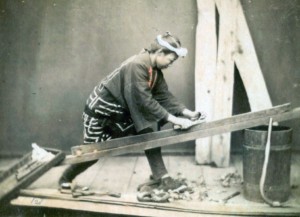 Perhaps you’ve heard of the Japanese word monozukuri (sometimes written as 物作り, but most often written as ものづくり). Literally translated, it means to make (zukuri) things (mono). Yet, there is so much meaning lost in translation. A better translation would be “manufacturing; craftsmanship; or making things by hand.” However, this translation also does not give justice to the weight and influence this idea has in Japan. Let me take you on a tour of the Japanese culture of monozukuri.
Perhaps you’ve heard of the Japanese word monozukuri (sometimes written as 物作り, but most often written as ものづくり). Literally translated, it means to make (zukuri) things (mono). Yet, there is so much meaning lost in translation. A better translation would be “manufacturing; craftsmanship; or making things by hand.” However, this translation also does not give justice to the weight and influence this idea has in Japan. Let me take you on a tour of the Japanese culture of monozukuri.
The Spirit of Monozukuri
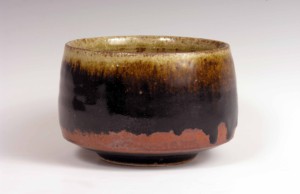 Monozukuri is so much more than creating products. If monozukuri was simply creation, then music would be nothing more than nice sounds, and a picture would be only a bunch of pretty colors.
Monozukuri is so much more than creating products. If monozukuri was simply creation, then music would be nothing more than nice sounds, and a picture would be only a bunch of pretty colors.
When Japanese talk about monozukuri, they mean much more than mere manufacturing. If they want to talk only about manufacturing, they would use Seizo (製造) or Seizan (生産) for manufacturing and production .
No, monozukuri is more than just crafting; it is a mindset, a spirit, a philosophy. It is the Japanese work ethic and the drive toward perfection. I apologize for all these fuzzy words, but it’s really difficult to explain this concept without sounding bombastic. Later on, I will give you examples on how this monozukuri establishes itself in everyday Japanese society.
The word itself is quite old and considered to be an original Japanese (i.e., not Chinese or Western-origin) word. Historically, it was used in connection with an individual artisan and craftsman who took pride in his or her products.

Over time, however, it also started to be used in industrial production. Factory work in Japan was often undesired and was considered to be 3K for kiken (危険, dangerous), kitsui (きつい, difficult), and kitanai (汚い, dirty). The use of monozukuri improved the image, standing, and self-value of industrial production. Suzuki, for example, probably used it from at least 1970 onward to describe its production.
The word got another boost in 1999, when the Japanese government created a law for the Promotion of Monozukuri: Basic Technology Promotion (ものづくり基盤技術振興基本法). This significantly improved the image of factory work and managed to bring the historically significant value of craftsmanship and artisans into modern manufacturing technology.
Below I will give a few examples for this spirit of manufacturing, both in the traditional craftsman style and in modern manufacturing industry.
Living National Treasures
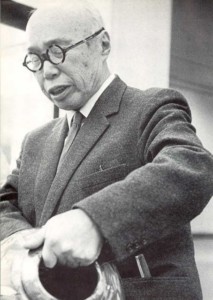
You probably know of famous artists like Shakespeare, Michelangelo, Picasso, Kahlo, and many more. Now do you know a famous potter? No? How about a famous smith? A carpenter? How about a weaver? I’d be surprised if you do. At least I didn’t.
Japan also has its share of famous Japanese artists. Many of them are officially recognized as Living National Treasures (人間国宝 Ningen Kokuhō) of Japan. They include performing artists like musicians, dancers, and actors in traditional Japanese arts.
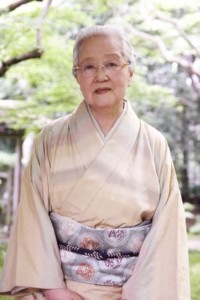
These Living National Treasures, however, have a second group of categories in crafts. There, Japan recognizes skilled artists and artisans in pottery, textiles, dying, lacquerware, metalworking, swordmaking, dollmaking, woodworking, and papermaking. Japan values such craftsmen on an similar level to traditional artists.
Even though these names are not household names, they do get recognition and respect for their skills. While monozukuri values craftsmanship, it also values the artisan. This applies not only to famous living (or dead) National Treasures; value of working with the hands extends to all craftsmen and artisans.
Update: Michel Baudin pointed out the similar Meilleur Ouvrier de France.
Value of Work
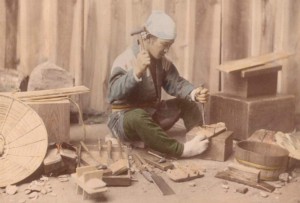 Yet another subtle way in which the Japanese express their value for work is in their greetings. At the end of the workday when the workers leave the factory, office, or general workplace, the custom greeting to the departing colleague is gokurosama ( ご苦労さま ), meaning thank you for your effort.
Yet another subtle way in which the Japanese express their value for work is in their greetings. At the end of the workday when the workers leave the factory, office, or general workplace, the custom greeting to the departing colleague is gokurosama ( ご苦労さま ), meaning thank you for your effort.
Yet, digging deeper into the Japanese character, this greeting implies more than just effort, directly connecting to hard and physical labor. The first kanji 苦 stands for pain, trouble, difficulty, hardship ; and the second kanji 労 stands for labor, toil, work, effort. Overall, this common message thanks the departing colleague for his hard and demanding physical work, even if the person is only an office worker. This is another example in how the value of physical work is deeply ingrained into the Japanese society.
Evaluation of Toyota Employees
 Recently I got access to a Toyota employee evaluation form (more in a later post). Employees at Toyota up to the plant manager level are evaluated every year on twenty factors. While the form contains some of the standard aspects, it also includes a lot of surprising elements.
Recently I got access to a Toyota employee evaluation form (more in a later post). Employees at Toyota up to the plant manager level are evaluated every year on twenty factors. While the form contains some of the standard aspects, it also includes a lot of surprising elements.
The very first entry in this list: Skills in manufacturing on the shop floor. Can the employees handle the standards within the allotted time frame? Again, this is for evaluations up to the level of plant manager! Second point: Can the employee maintain good product quality at work? Again, this is up to the plant manager.
It seems to me that Toyota puts an enormous focus on actual physical work in its evaluation. This is also reflected on the shop floor. Everybody at Toyota starts out assembling cars. No matter if you are a manager or a designer, your first job after entering Toyota is producing cars on the shop floor.
At Toyota they also have master craftsmen called Takumi (匠, master craftsman or artisan). These are highly specialized expert craftsmen with a deep focus on one particular manufacturing technique (e.g., painting, electronic welding, sewing, or automotive body quality). They do a major part of their work by hand rather than with robots, to get a deeper understanding of the process. They are used to train others, solve problems, and help program robots and machines worldwide. Reportedly, around five hundred takumi exist at Toyota. While takumi is not an official job title, Toyota invests significant time and effort in training these takumi.
Monozukuri Spin-offs
A spin-off of monozukuri is hitozukuri (人作り, making people) for developing people. This includes the lifelong education, training, and coaching of people, not only in the classroom but especially at work.
At Nissan they are also kotozukuri (事作り, making stories) for “brand storytelling,” with the goal of entering into dialogue with the customer. However, this is little used outside of Nissan.
Watching Japanese People Work

Whenever I am in Japan, I enjoy watching the Japanese work. In most cases their work methods and standards are much better and more focused than in the Western world. This seems to be not only training, but part of the Japanese culture. (Note that office work, however, does not always have this crisp feeling, and a lot of time in the office is wasted away. But then, with twelve-hour workdays, it is impossible to be efficient all the time. There is huge potential for Japan to reduce office work hours while becoming more efficient and increasing their usually poor work-life balance.)

While monozukuri focuses on the manufacturing aspect, it also strongly influences the service part of Japan.
In previous posts I showed examples of Japanese Standard Pointing and Calling and The Japanese Supermarket Checkout.
Overall, every time I am in Japan, I am amazed at the Japanese work ethic and their spirit in making things. Of course, like in any country, the people are not all identical, and you surely can find slackers and good-for-nothings in Japan too. Yet, overall I feel that the Japanese people take much more pride in their work, and are much more respected for it. This applies not only to individual artisans, but also to people like factory workers who are only a minor cog in a large system. They, too, get much more respect than what a Westerner would consider appropriate based on their salary level.
A Story of a Shampoo Refill Bottle
 Let me give you another example how deeply ingrained this culture of monozukuri is in Japan. A while ago I was on a domestic flight within Japan, and the plane had no video monitors in the seat (only big ones for everybody). In the US, they would be probably showing a cartoon of a robot talking of peace while beating the bad guys to a pulp, or a video of the Kardashians doing … whatever it is the Kardashians are doing (I haven’t figured that one out yet).
Let me give you another example how deeply ingrained this culture of monozukuri is in Japan. A while ago I was on a domestic flight within Japan, and the plane had no video monitors in the seat (only big ones for everybody). In the US, they would be probably showing a cartoon of a robot talking of peace while beating the bad guys to a pulp, or a video of the Kardashians doing … whatever it is the Kardashians are doing (I haven’t figured that one out yet).
But on this domestic Japanese flight, they entertained the guests with a twenty-minute documentary on how to optimize a shampoo refill pack! It wasn’t even a real shampoo bottle, only the refill pack, but for twenty minutes they described in detail design features to maximize customer experience to reduce waste and increase comfort and safety. They coated the inside of the foil pack and used a special origami folding to minimize the wasted shampoo stuck in the container. They described how they optimized the opening with a smaller hole in a bigger one so less shampoo gets stuck in the hole. As a safety feature they added a jagged outer edge to the outlet so nobody accidentally mistakes it for a jelly drink (that is a thing in Japan). The designers were visibly proud of their work, and this was the video for all three hundred people on the flight in economy.

If a US airline media manager would select this for the audience, he probably would be fired. The product would even be too much of a fringe product for the special interest “How It’s Made” series on Discovery Channel. Yet in Japan it is absolutely acceptable to go into great detail on the design aspects of a bloody shampoo refill bottle! I find this amazing, and a great example of the culture of monozukuri. (I also bought the refill pack to take it apart and see it myself. However, lacking a proper container to fill it in, I now have a soft drink pet bottle filled with shampoo. I hope you appreciate my efforts 🙂 )
I hope this post was interesting to you. Now, go out, be proud of what you do and try to do it well, be even more appreciative of what your people do for you, and organize your industry!

Very interesting. Thank you.
My introduction to all this was 30+ years ago, when the tradition was to respect making things: the idea (Buddhist?) was that ‘a little bit of you’ went into the product – in contrast perhaps to the western / Christian perspective that work was some sort of penalty. There was in Japan a view that if you had anything about you, you would get a job in Manufacturing …creating value, wealth… but if you were a bit dim, they’d give you a blue suit and a calculator and you could get a job in a bank shuffling money around or something.
This was changing though. One would meet people who professed to be musicians or photographers or something ….but eventually confessed to working in factories! Nissan struggled to recruit, and rather than a family connection being a useful means of getting a plum job, the nepotism worked the other way round. You might join the company so as not to let the family name down if other family members worked there.
An interesting aspect was ‘The Skill Olympics’, which I thought was a great idea: find the best at a particular job in each plant, and then have an inter-plant competition. But in my particular patch, the local put forward as champ was the supervisor – and he was far from the best in skill, quality and speed! ‘Ah, but he is the Supervisor’, it was explained to me!!
There was also a grading / appraisal system whereby everyone could feel that they were making some advancement year-on-year. There were some skilled operators paid more than Supervisors because pay reflected many other things rather than just ‘rank’: reaching a certain birthday or having children were taken into consideration.
Another interesting feature was that there was a union – but just a company union. And the local ‘shop steward’ was the Senior Supervisor!
Great post, as usual. Thanks for sharing your thoughts
Hi Steve, interesting historic insight. Thank you for confirming that the prestige of factory work improved in the last decades. Also interesting is that “the supervisor wins” the skill olympics. I can totally see that in Japan. The unions is also my experience, and it is based on the US starting US style unions after the war in Japan, which were taken over by the communists, after which the US changed the laws and made the unions powerless. Many thanks for the long quality comment 🙂
Chris
Christoph – great post about some of the foundational Japanese cultural concepts that are deeply embedded in the Toyota Production System – and what often is lost in translation to Western cultures. I look forward to seeing you in January 2018 in Japan and exploring these principles in action.
Many thanks, Katie. Likewise looking forward to see you in January!
Thanks for the informative article Christoph!
What impressed me in the Japanese approach to Monozukuri in contrast to the Western is how much they put the human and its ability in forefront rather the technology. A great topic for research…
Great – completely reversed my thoughts – Japanese culture is immensely wonderful!
Hello Todor and Girifar, just make sure you also read my post on The Dark Side of Japanese Working Society!
Anomalys?
Why is/was there a large recall ‘program’ for some Nissan models?
Why did the once head hancho have to exit Japan the way he did?
Some events within Jap’ businesses don’t appear to align with the Monozukuri philosophy, or did they occur because they did’nt ?
The models were’nt made in Japan & the person was’nt Japanese – is there a correlation?
Great Post. I think All religions focus on quality of work as an important contribution to self and society.
I suggest most of us miss the point of Leadership is there to support the employee with the right habits and behaviours.
Please, Can you talk about “Kotozukuzi” in Monozukuri, Hitozukuri, Kotozukuri.
Thanks you!
From Viet Nam
Hồng Nhung Từ https://www.facebook.com/login/?next=https%3A%2F%2Fwww.facebook.com%2Fpeople%2FH%25E1%25BB%2593ng-Nhung-T%25E1%25BB%25AB%2F100003017606070%2F
Hello Rose, I have brief entries in my glossary for Monozukuri, Hitozukuri, Kotozukuri. Do these help? Maybe at one point I should make a post on Hitozukuri.